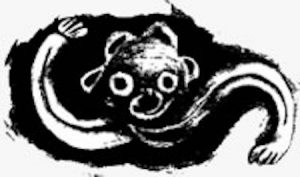
Guabancex in her traditional image
Guabancex is the supreme storm deity of the ancient Taino people. They were located across Florida and much of the Carribbean on islands such as Puerto Rico. She is also known as the ‘Lady of the Winds’ and was believed to be responsible for the onset of all violent storms. This also includes all natural disasters, such as earthquakes and volcanoes in the region.
Guabancex was commonly depicted with an angry face in the centre of the image, with her arms flailing on either side in a S shape. She wasn’t believed to be a malevolent deity, rather a manifestation of the supreme goddess Atabey. Atabey was believed to be the Taino ‘Mother Nature’, that is, a creator goddess who represented fertility and maternal instinct. Guabancex was her fierce and destructive side, who could wipe the slate clean with one swoop of a hand. She wasn’t believed to be malevolent, but would bring retribution on those who neglected their worship of the Zemi or ancestral gods.
Guabancex was believed to work alongside three assistants called Coatrischie, Guatauva, and Hu-Rakan. These minor deities were responsible for heavy rain, thunder and lightning, and hurricanes chronologically. Whilst all could be devastating on their own, when working together they regularly caused a disastrous result. Guatauva was known as the chief assistant, and one whom Guabancex would regularly use to call upon the others for an increased intensity. The deity Hu-Rakan is believed to be the namesake of the hurricanes. However, he was also responsible for the creation of cyclones and tornadoes.
Ramón Pané was a 15th century Catalan Monk, who became a companion of Christopher Columbus on his second voyage to the Indies to learn the indigenous language of the Taino people. Guabancex features in his writings as a prominent spirit that controlled all catastrophic weather patterns. She was escorted by two male companions known as Guatabá and Coatrisquie. Guatabá, like the previously mentioned Guatauva was believed to bring about the thunder and lightning in a storm cycle. Similarly, Coatrisquie, like Coatrischie, was responsible for bringing a rain that could cause a devastating flood over the land. In these texts, Pané occasionally interchanged the names of Guabancex and Hu-Rakan to reference the same deity.
However, these names and spellings for the assistants are also seen in reference to a male deity known as Juracán. This deity was also known as the god of chaos to the Taino people, with some believing it was from this name that we derive the word ‘hurricane’. While being related to the storms, many sources agree that he was not involved in the work of the storms himself. Instead, this was left to Guabancex with Guatabá and Coatrisquie as her assistants.
Most of the mythology in this region was orally transmitted and the names are extremely similar. As a result, it is likely that these four deities were the same but portrayed in a different order of importance depending on the location of the legend.
-Devon Allen
Junior Girl
Girl Museum Inc.
